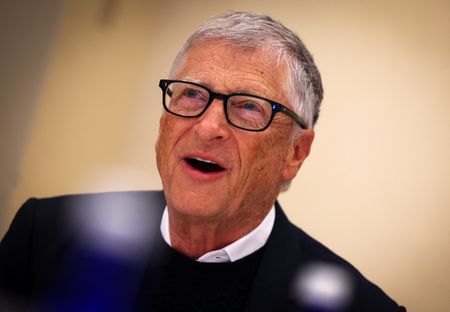LONDON (Reuters) – The Bank of England cut its main interest rate by 0.25 percentage points to 4.25% on Thursday, though with an unexpected three-way split among policymakers as U.S. President Donald Trump’s tariffs weigh on global economic growth.
The BoE’s Monetary Policy Committee voted 5-4 in favour of the decision to cut rates by a quarter point. Two members, Swati Dhingra and Alan Taylor, voted for a bigger half-point cut while Chief Economist Huw Pill and external member Catherine Mann wanted to keep interest rates on hold.
The BoE said it thought the increase in tariffs by the U.S. and other countries would weigh somewhat on British economic growth and push down on inflation in Britain but it stressed how unclear the outlook remained.
MARKET REACTION:
STOCKS: The benchmark FTSE 100 index pared gains and was last up 0.3%.
FOREX: Sterling rose against the dollar after the decision, last up 0.2% to $1.3320.
BONDS AND MONEY MARKETS: Two-year gilt yields jumped and were last 7 bps higher at 3.88%. Traders were pricing in less than a 20% chance of a June cut and around 57 bps of total rate cuts by year-end.
COMMENTS:
PHILIP SHAW, CHIEF ECONOMIST, INVESTEC, LONDON:
“It’s no surprise that the committee as a whole voted to bring rates down, what perhaps was surprising that two members including chief economist Huw Pill preferred to leave rates unchanged.”
“That may reduce speculation as to a possible back-to-back reduction at next month’s meeting. Our base line case remains that we will see the next cut in August.”
LUKE BARTHOLOMEW, DEPUTY CHIEF ECONOMIST, ABERDEEN, LONDON:
“The Monetary Policy Committee is clearly very divided on how policy should respond to the many shocks currently hitting the economy.”
“This is highly unusual and will make it hard for the Bank to send a clear signal to the market about the likely path of policy. But with the bank maintaining its guidance that further cuts will be ‘gradual and careful’, the chance of another cut in June probably have fallen significantly.”
“We still think the Bank will cut rates at least twice more later this year, but much like the Fed’s message yesterday, UK policymakers will want to see more data on how tariffs and domestic tax increases are being digested by the economy before moving decisively.”
ANDREW WISHART, SENIOR UK ECONOMIST, BERENBERG, LONDON:
“The vote split was obviously more hawkish than expected with two members voting to keep on hold, I think, worried by how aggressive the rate cuts priced in by the market had become and also signs that core inflation is going to remain elevated as companies pass through quite a lot of the cost increases from the wage and tax increases in April.”
“But there was also something for the doves in the communications, because the Bank still expects inflation to drop back to 2% in the forecast, but compared to market pricing beforehand I think they ruled out moving to faster paced cuts by keeping the gradual language in there.
“They will probably be on hold again in June and then reassess when we get to the August meeting.”
GEORGE BROWN, SENIOR ECONOMIST, SCHRODERS, LONDON:
“Today’s decision came as no surprise to anyone. But going forward, the Bank of England has far less scope to cut rates than the market currently expects.”
“While Trump’s tariffs will provide some marginal relief through lower goods prices, the fundamental issue for the UK is that it continues to face considerable capacity constraints. As such, inflation looks set to rise again later this year as a result of disappointing productivity and sticky wage growth.”
“To our minds, this is consistent with the Bank only taking interest rates as low as around 4% this rate-cutting cycle.”
JEREMY BATSTONE-CARR, STRATEGIST, RAYMOND JAMES INVESTMENT SERVICES, FRANCE:
“As important for hard-pressed British households and businesses as today’s decision is, the bank is cautiously signalling it is likely to go further in coming months, looking past the strong likelihood that near-term inflationary pressures are likely to rise.”
“Lower rates are coming, but it may be autumn before the Old Lady feels confident enough in the outlook to ease borrowing costs again.”
JULIUS BENDIKAS, EUROPEAN HEAD OF ECONOMICS AND DYNAMIC ASSET ALLOCATION, MERCER, LONDON:
“The Bank’s Monetary Policy Committee faces a tricky balancing act with inflation and wages still elevated. Global trade issues are likely to put downward pressure on both growth and inflation. We expect the Bank to keep cutting rates, reaching 3.5% or lower by 2026, as price and wage inflation moderate further.”
(Reporting by Reuters Markets Team, Compiled by Yoruk Bahceli, editing by Alun John)











